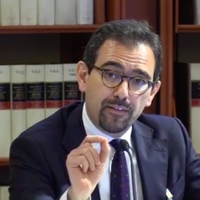Academic Publications by Raisa Cachalia

South African Journal on Human Rights, 2022
In the earlier decision in State Information Technology Agency SOC Ltd v Gijima Holdings (Pty) Lt... more In the earlier decision in State Information Technology Agency SOC Ltd v Gijima Holdings (Pty) Ltd the Constitutional Court concluded that the legality principle and not the Promotion of Administrative Justice Act 3 of 2000 (the PAJA) applies to state self-reviews of administrative decisions. This was justified on the basis that the state, unlike a private litigant, is not a bearer of the right to administrative justice and is, for this reason, prevented from relying on the PAJA to review its own prior decisions (the Gijima principle). The Court, however, stated that its conclusion was limited to instances where a state organ reviews its own decision and acts in its own interest for the purposes of section 38(a) of the Constitution. This note explores the implications of the SCA’s later decision in Compcare Wellness Medical Scheme v Registrar of Medical Schemes for the Gijima principle. In substance, Compcare concluded that whenever a state organ seeks the review and setting aside of its own administrative action or that of another state organ, it must rely on the PAJA. This is because it will always be seeking to enforce the right to just administrative action in the public interest in terms of section 38(d) of the Constitution, and never in its own interests for the purposes of section 38(a). Although Compcare was concerned with a scenario that fell outside of the Gijima principle, the principled effect of the judgment is to resuscitate the PAJA in all state self-reviews of administrative actions and in so doing, to defeat the basic premise in Gijima that the state cannot rely on the PAJA.

South African Law Journal, 2020
Flowing from the constitutional imprimatur in s 172(1) to further ‘justice and equity’ (‘J&E’), t... more Flowing from the constitutional imprimatur in s 172(1) to further ‘justice and equity’ (‘J&E’), the courts have made important strides in developing a framework for remedying irregular public procurement. They have not, however, done so clearly and coherently; nor in a way that encourages predictability in remedial outcomes. In response, we have sought to leverage an argument for ‘reasonable certainty’ as a rule-of-law justification for refining the framework in a comprehensive and helpful way that does not pit form against ‘individualised justice’. We have done so against the backdrop of two hypothetical tender scenarios – a review by a private contractor and a state self-review – based upon a pattern emerging from the jurisprudence. Through our analysis, we illustrate that ultimately the J&E enquiry is a kind of proportionality assessment that has, at its heart, an appreciation of the overall ‘impact’ of setting a tender aside, from both a practical and principled perspective. We posit a two-step approach to addressing this overarching ‘impact question’: a big-picture assessment of the various interests to be weighed in the balance, followed by the particularised balancing of these affected interests with reference to several open-list factors. Ultimately, we seek to provide a principled and pragmatic guide for the exercise of the courts’ remedial discretion and so draw the analysis together by applying this framework to the scenarios sketched.

ABSTRACT
On 2 December 2016, the Supreme Court of Appeal (‘SCA’) handed down judgment in the matt... more ABSTRACT
On 2 December 2016, the Supreme Court of Appeal (‘SCA’) handed down judgment in the matter of Minister of Justice and Constitutional Development v South African Restructuring and Insolvency Practitioners Association (‘SARIPA’). This is a significant judgment on the test for assessing the constitutionality of a so-called ‘affirmative action’, or restitutionary, measure within the meaning of section 9(2) of the Constitution. SARIPA invites us to revisit the original formulation of this test as propounded by Moseneke J in the seminal judgment of Minister of Justice v Van Heerden. The policy in issue in SARIPA embodied a quintessential quota system aimed at effecting transformation of the insolvency profession. Both the High Court and SCA found this mechanical, alphabetised roster system for the appointment of insolvency practitioners to be excessively rigid for want of any general discretion to depart from the scheme. For this reason – on the strength of earlier dicta in South African Police Service v Solidarity obo Barnard and then Solidarity v Department of Correctional Services – it was held to fall foul of the section 9(2) test. Interestingly, these earlier cases were decided in the context of the Employment Equity Act, 1998 (‘EEA’), which expressly prohibits quotas. The decision in SARIPA to extend the quota ban to circumstances outside the purview of the EEA presents a noteworthy development in our law and ought to be welcomed for its congruence with the first principles of the Van Heerden test which are grounded in a purposive appreciation of a restitutionary measure as a flexible and context-specific tool for the achievement of substantive equality. Unfortunately, the laudable outcome in SARIPA was reached without clear and rigorous judicial justification. In this article we thus analyse and locate SARIPA within the s 9(2) Van Heerden framework for assessing the constitutionality of a redress measure, in order to propound a more compelling justification for the SCA’s conclusion on the constitutional repugnancy of quota systems outside the EEA context.

During the course of this case note I level a two-fold critique of the approach adopted by the ma... more During the course of this case note I level a two-fold critique of the approach adopted by the majority of the Court in My Vote Counts v the Speaker of the National Assembly. The first is that, for the simple reason that the subsidiarity principle did not apply the technical reasons relied on by the majority for not deciding the merits were erroneous, misconceived and did not withstand scrutiny. The second relates to the majority’s insistence that the formal rules and barriers of procedure prevented it from interpreting the rights in questions and ultimately, from reaching the question of disclosure. While it is true that courts are, at times, required to uphold the force of legal rules and the demands of procedure, my argument is that, given the obvious public importance of the rights and issues at stake – not to mention the veritable stalemate in the democratic process – the Court could have reached the matters of substance, even if the subsidiarity principle prevented it from granting the applicant’s request to compel the enactment of disclosure-specific legislation by Parliament
Constitutional Court Review, 2015

In this article I have argued that the state, as a contracting party, is always different and for... more In this article I have argued that the state, as a contracting party, is always different and for this reason government contracts ought to be treated differently all of the time. The special characteristics of public authorities also explain why, more than a decade ago in Logbro Properties CC v Bedderson, Cameron JA said that administrative principles “framed” the contractual relationship. But rather than appealing to what makes the state unique, the legal tendency in South Africa has been to obsess over the formalistic question whether the actions of a public authority ought to be subject to public or private law. This has impoverished the regulatory debate and is a persistent distraction from the crucial question why the state’s peculiar features matter in the contractual context. My argument is that they do matter and in fact, they provide the best reasons for subjecting the state contractor to higher constitutional standards than the ordinary contractor (even if the content and scope of these standards vary from case to case). Recognition of the state’s distinctiveness, in the legal principles that we develop and apply, is thus the essential rst step in developing an appropriate regulatory response to the hybrid anomaly that is the government contract.
Constitutional Law blogs by Raisa Cachalia
Caveat Legal (Pty) Ltd Blogs by Raisa Cachalia
The proliferation of digitised-storage of data has moved global attention to the blockchain – the... more The proliferation of digitised-storage of data has moved global attention to the blockchain – the technology that underpins the cryptocurrency, Bitcoin. While the future of Bitcoin is uncertain, many are saying that blockchain technology will revolutionise the way in which individuals and businesses transact and store information in today’s digitised world. The full potential of the technology is, however, almost impossible to predict. It could, for example, be used to store large quantities of personal data but it is unclear what effect this would have on the right to privacy and compliance with the partially in force Protection of Personal Information Act, 2013 (POPI).
In this age of technological innovation, with growing numbers of start-ups developing software an... more In this age of technological innovation, with growing numbers of start-ups developing software and mobile apps, conditions are absolutely prime for emerging players to flourish. For the developer looking to enter the market, an appreciation of the regulatory landscape is vital to ensure that you operate within the parameters of the law and are properly protected against the adverse consequences of non-compliance.

Approaching government with an unsolicited offering is fraught with uncertainty, and an understan... more Approaching government with an unsolicited offering is fraught with uncertainty, and an understanding of the regulatory landscape is important for businesses seeking to manage the risks of doing so.
While these projects have the potential to stimulate innovation, improve service delivery and generally enhance the quality of service to the public, there are good reasons for prospective offerors to be cautious. First, the failure to correctly categorise an offering could lead to its exclusion from the process. Second, depending on the extent of intellectual property protection available – in some cases none – there are significant risks relating to control over what happens to a concept or idea once it is shared with government. Third, non-adherence to the framework carries the risk of a successful award being challenged in court for undermining the constitutional standards of good public administration.
Papers by Raisa Cachalia
Oxford University Press eBooks, Dec 20, 2023
Oxford University Press eBooks, Dec 20, 2023
Oxford University Press eBooks, Dec 20, 2023
Constitutional Court Review

South African Journal on Human Rights
In the earlier decision in State Information Technology Agency SOC Ltd v Gijima Holdings (Pty) Lt... more In the earlier decision in State Information Technology Agency SOC Ltd v Gijima Holdings (Pty) Ltd the Constitutional Court concluded that the legality principle and not the Promotion of Administrative Justice Act 3 of 2000 (the PAJA) applies to state self-reviews of administrative decisions. This was justified on the basis that the state, unlike a private litigant, is not a bearer of the right to administrative justice and is, for this reason, prevented from relying on the PAJA to review its own prior decisions (the Gijima principle). The Court, however, stated that its conclusion was limited to instances where a state organ reviews its own decision and acts in its own interest for the purposes of section 38(a) of the Constitution. This note explores the implications of the SCA’s later decision in Compcare Wellness Medical Scheme v Registrar of Medical Schemes for the Gijima principle. In substance, Compcare concluded that whenever a state organ seeks the review and setting aside of its own administrative action or that of another state organ, it must rely on the PAJA. This is because it will always be seeking to enforce the right to just administrative action in the public interest in terms of section 38(d) of the Constitution, and never in its own interests for the purposes of section 38(a). Although Compcare was concerned with a scenario that fell outside of the Gijima principle, the principled effect of the judgment is to resuscitate the PAJA in all state self-reviews of administrative actions and in so doing, to defeat the basic premise in Gijima that the state cannot rely on the PAJA.

South African Law Journal, 2020
Flowing from the constitutional imprimatur in s 172(1) to further ‘justice and equity’ (‘J&am... more Flowing from the constitutional imprimatur in s 172(1) to further ‘justice and equity’ (‘J&E’), the courts have made important strides in developing a framework for remedying irregular public procurement. They have not, however, done so clearly and coherently; nor in a way that encourages predictability in remedial outcomes. In response, we have sought to leverage an argument for ‘reasonable certainty’ as a rule-of-law justification for refining the framework in a comprehensive and helpful way that does not pit form against ‘individualised justice’. We have done so against the backdrop of two hypothetical tender scenarios – a review by a private contractor and a state self-review – based upon a pattern emerging from the jurisprudence. Through our analysis, we illustrate that ultimately the J&E enquiry is a kind of proportionality assessment that has, at its heart, an appreciation of the overall ‘impact’ of setting a tender aside, from both a practical and principled perspective. We posit a two-step approach to addressing this overarching ‘impact question’: a big-picture assessment of the various interests to be weighed in the balance, followed by the particularised balancing of these affected interests with reference to several open-list factors. Ultimately, we seek to provide a principled and pragmatic guide for the exercise of the courts’ remedial discretion and so draw the analysis together by applying this framework to the scenarios sketched.











Uploads
Academic Publications by Raisa Cachalia
On 2 December 2016, the Supreme Court of Appeal (‘SCA’) handed down judgment in the matter of Minister of Justice and Constitutional Development v South African Restructuring and Insolvency Practitioners Association (‘SARIPA’). This is a significant judgment on the test for assessing the constitutionality of a so-called ‘affirmative action’, or restitutionary, measure within the meaning of section 9(2) of the Constitution. SARIPA invites us to revisit the original formulation of this test as propounded by Moseneke J in the seminal judgment of Minister of Justice v Van Heerden. The policy in issue in SARIPA embodied a quintessential quota system aimed at effecting transformation of the insolvency profession. Both the High Court and SCA found this mechanical, alphabetised roster system for the appointment of insolvency practitioners to be excessively rigid for want of any general discretion to depart from the scheme. For this reason – on the strength of earlier dicta in South African Police Service v Solidarity obo Barnard and then Solidarity v Department of Correctional Services – it was held to fall foul of the section 9(2) test. Interestingly, these earlier cases were decided in the context of the Employment Equity Act, 1998 (‘EEA’), which expressly prohibits quotas. The decision in SARIPA to extend the quota ban to circumstances outside the purview of the EEA presents a noteworthy development in our law and ought to be welcomed for its congruence with the first principles of the Van Heerden test which are grounded in a purposive appreciation of a restitutionary measure as a flexible and context-specific tool for the achievement of substantive equality. Unfortunately, the laudable outcome in SARIPA was reached without clear and rigorous judicial justification. In this article we thus analyse and locate SARIPA within the s 9(2) Van Heerden framework for assessing the constitutionality of a redress measure, in order to propound a more compelling justification for the SCA’s conclusion on the constitutional repugnancy of quota systems outside the EEA context.
Constitutional Law blogs by Raisa Cachalia
Caveat Legal (Pty) Ltd Blogs by Raisa Cachalia
While these projects have the potential to stimulate innovation, improve service delivery and generally enhance the quality of service to the public, there are good reasons for prospective offerors to be cautious. First, the failure to correctly categorise an offering could lead to its exclusion from the process. Second, depending on the extent of intellectual property protection available – in some cases none – there are significant risks relating to control over what happens to a concept or idea once it is shared with government. Third, non-adherence to the framework carries the risk of a successful award being challenged in court for undermining the constitutional standards of good public administration.
Papers by Raisa Cachalia
On 2 December 2016, the Supreme Court of Appeal (‘SCA’) handed down judgment in the matter of Minister of Justice and Constitutional Development v South African Restructuring and Insolvency Practitioners Association (‘SARIPA’). This is a significant judgment on the test for assessing the constitutionality of a so-called ‘affirmative action’, or restitutionary, measure within the meaning of section 9(2) of the Constitution. SARIPA invites us to revisit the original formulation of this test as propounded by Moseneke J in the seminal judgment of Minister of Justice v Van Heerden. The policy in issue in SARIPA embodied a quintessential quota system aimed at effecting transformation of the insolvency profession. Both the High Court and SCA found this mechanical, alphabetised roster system for the appointment of insolvency practitioners to be excessively rigid for want of any general discretion to depart from the scheme. For this reason – on the strength of earlier dicta in South African Police Service v Solidarity obo Barnard and then Solidarity v Department of Correctional Services – it was held to fall foul of the section 9(2) test. Interestingly, these earlier cases were decided in the context of the Employment Equity Act, 1998 (‘EEA’), which expressly prohibits quotas. The decision in SARIPA to extend the quota ban to circumstances outside the purview of the EEA presents a noteworthy development in our law and ought to be welcomed for its congruence with the first principles of the Van Heerden test which are grounded in a purposive appreciation of a restitutionary measure as a flexible and context-specific tool for the achievement of substantive equality. Unfortunately, the laudable outcome in SARIPA was reached without clear and rigorous judicial justification. In this article we thus analyse and locate SARIPA within the s 9(2) Van Heerden framework for assessing the constitutionality of a redress measure, in order to propound a more compelling justification for the SCA’s conclusion on the constitutional repugnancy of quota systems outside the EEA context.
While these projects have the potential to stimulate innovation, improve service delivery and generally enhance the quality of service to the public, there are good reasons for prospective offerors to be cautious. First, the failure to correctly categorise an offering could lead to its exclusion from the process. Second, depending on the extent of intellectual property protection available – in some cases none – there are significant risks relating to control over what happens to a concept or idea once it is shared with government. Third, non-adherence to the framework carries the risk of a successful award being challenged in court for undermining the constitutional standards of good public administration.